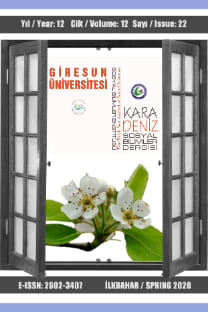Dubliners’ta Ölüm Kavramı
Ölüm kavramı felsefe ve sosyoloji bilim dallarının yanı sıra edebiyatın da tartışma konusu olmuştur. James Joyce ölüm temasını on beş kısa hikâyeden oluşan Dubliners adlı yapıtında oldukça yoğun bir şekilde kullanmıştır. Bu hikâyeler ölümün yanı sıra, ölümle özdeşleştirilmiş rutin hayat tarzı ve maddi-manevi paralize olan karakterleri de ele almaktadır. Adı geçen temaların birçok hikâyede kullanılmış olması, Dubliners’ı bu açıdan değerlendirmenin gerekliliği düşüncesini ortaya çıkarmıştır. Bu çalışma bu ihtiyacı karşılamak üzere hazırlanmıştır.
The Concept of Death in Joyce’s Dubliners ‘Dubliners’ta Ölüm Kavramı’
The concept of ‘death’ has been a matter of debate in many different disciplines, such as philosophy, sociology and literature. Death is a common experience of all human beings and it has a substantial effect on formation of cultures and literature. James Joyce has manipulated this concept intensively in Dubliners. Dubliners consists of fifteen short stories. These stories have common themes such as death, routine lifecycle, moral and material paralysis of some characters. Although the stories are ...
Keywords:
-,
___
- Connolly, T. E. (1965). Joyce’s “The Sisters”: A Pennyworth of Snuff. College English, Vol. 27, No.3, pp. 189-195.
- Delany, P. (1972). Joyce’s Political Development and the Aesthetic of Dubliners. College English, Vol. 34, No. 2,
- Marxist Interpretations of Mailer, Woolf, Wright and Others, pp. 256-266. French, M. (1987). Missing Pieces in Joyce’s Dubliners. Twentieth Century Literature, Vol. 24, No. 4, pp. 443-472.
- Joyce, J., (2011). Dubliners. HarperCollins Publishers.
- Montgomery, B. Br. (1978). A Nietzschean Reading of Joyce’s “Dubliners”. Journal of the American Academy of
- Religion, Vol. 46, No. 1, p. 65. Murdoch, I. (2001). The Sovereignty of Good over other Concepts. Routledge Classics Press.
- Walzl, F. L. (1961). Joyce’s Patterns of Paralysis in Dubliners. College English, Vol. 22, No. 7, pp. 519-520.
- ISSN: 2602-3407
- Yayın Aralığı: 2
- Başlangıç: 2009
- Yayıncı: -
